Deploying Cloud Computing Environment for Indian Railways Project
VerifiedAdded on 2022/12/28
|16
|3754
|1
Project
AI Summary
This project presents a comprehensive case study on deploying a cloud computing environment, named RailCloud, for the Indian Railways. The project begins with an introduction to cloud computing and its benefits, followed by a problem statement outlining the need for cloud adoption to enhance railway services. The strategic phase details the involvement of key stakeholders, including the Minister of Railways and CRIS management, in the decision-making process. A work plan outlines the project's timeline, from requirement gathering to deployment and closure. The project recommends a hybrid cloud deployment model and discusses the selection of cloud service models (SaaS, PaaS, and IaaS) suitable for the RailCloud project. It also addresses the assessment and resolution of security and privacy issues, integration with existing enterprise services, and the importance of developing a proof-of-concept before full-scale production. The project also provides an overview of the roles and responsibilities of various teams involved in managing the cloud environment.
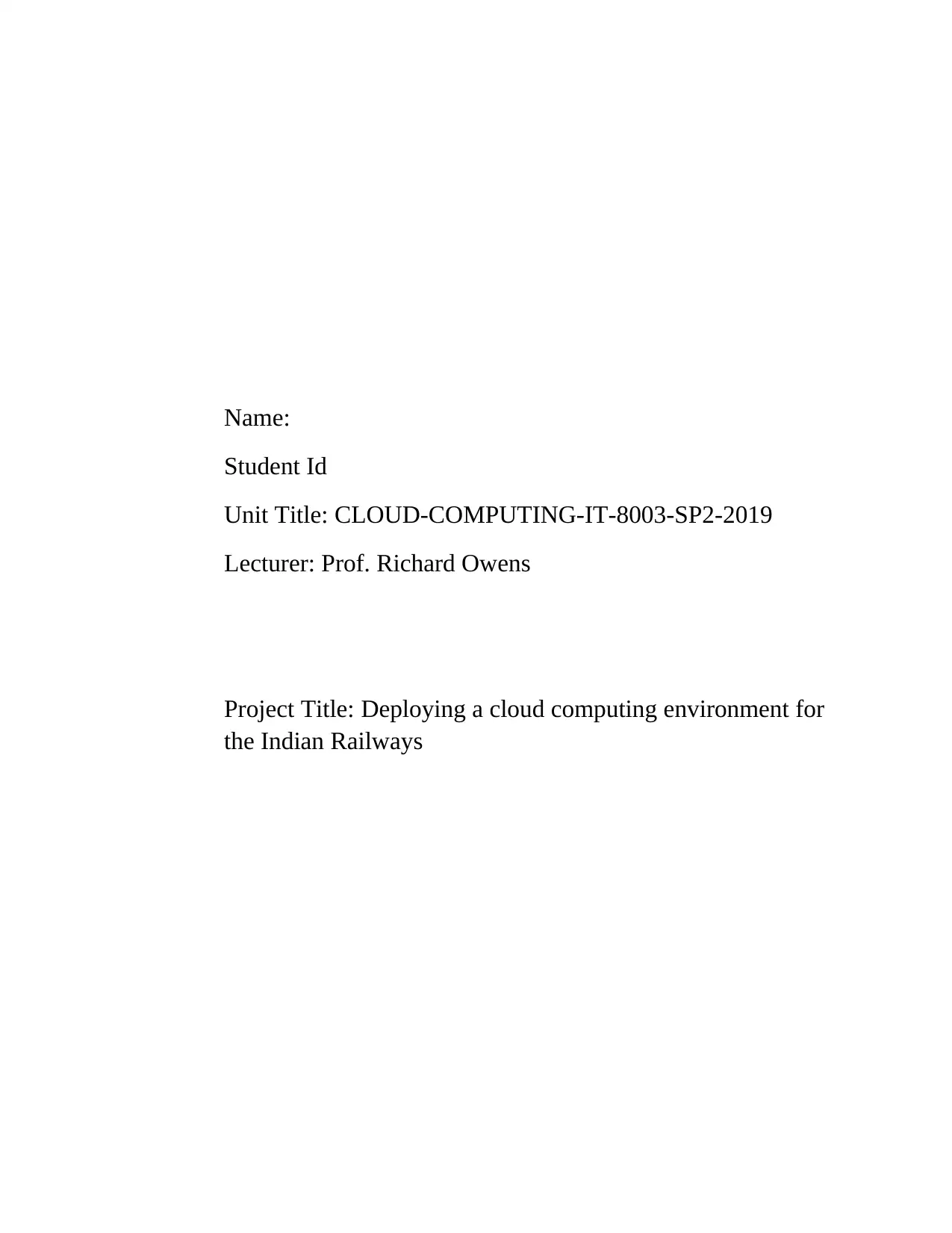
Name:
Student Id
Unit Title: CLOUD-COMPUTING-IT-8003-SP2-2019
Lecturer: Prof. Richard Owens
Project Title: Deploying a cloud computing environment for
the Indian Railways
Student Id
Unit Title: CLOUD-COMPUTING-IT-8003-SP2-2019
Lecturer: Prof. Richard Owens
Project Title: Deploying a cloud computing environment for
the Indian Railways
Paraphrase This Document
Need a fresh take? Get an instant paraphrase of this document with our AI Paraphraser
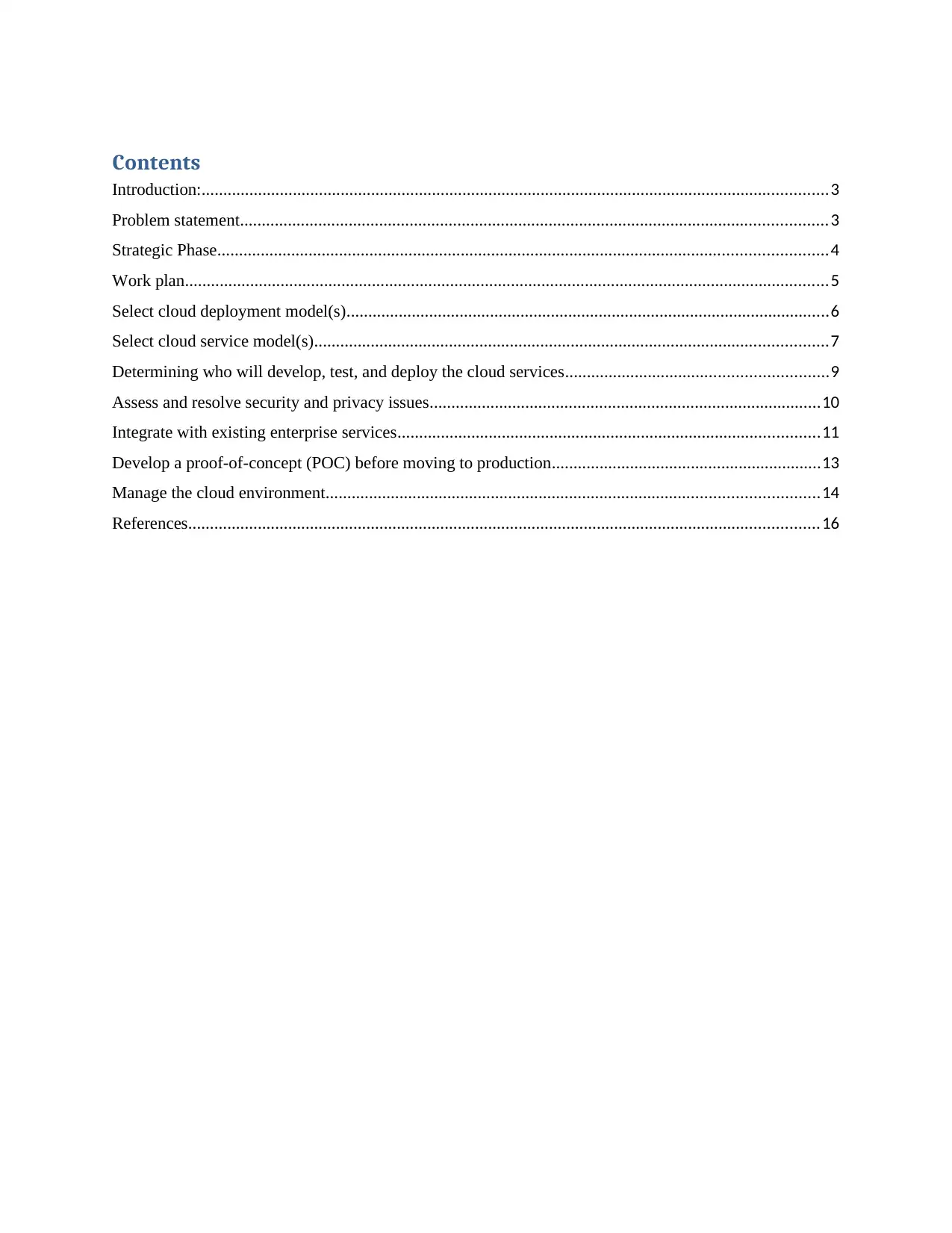
Contents
Introduction:................................................................................................................................................3
Problem statement.......................................................................................................................................3
Strategic Phase............................................................................................................................................4
Work plan....................................................................................................................................................5
Select cloud deployment model(s)...............................................................................................................6
Select cloud service model(s)......................................................................................................................7
Determining who will develop, test, and deploy the cloud services............................................................9
Assess and resolve security and privacy issues..........................................................................................10
Integrate with existing enterprise services.................................................................................................11
Develop a proof-of-concept (POC) before moving to production..............................................................13
Manage the cloud environment.................................................................................................................14
References.................................................................................................................................................16
Introduction:................................................................................................................................................3
Problem statement.......................................................................................................................................3
Strategic Phase............................................................................................................................................4
Work plan....................................................................................................................................................5
Select cloud deployment model(s)...............................................................................................................6
Select cloud service model(s)......................................................................................................................7
Determining who will develop, test, and deploy the cloud services............................................................9
Assess and resolve security and privacy issues..........................................................................................10
Integrate with existing enterprise services.................................................................................................11
Develop a proof-of-concept (POC) before moving to production..............................................................13
Manage the cloud environment.................................................................................................................14
References.................................................................................................................................................16
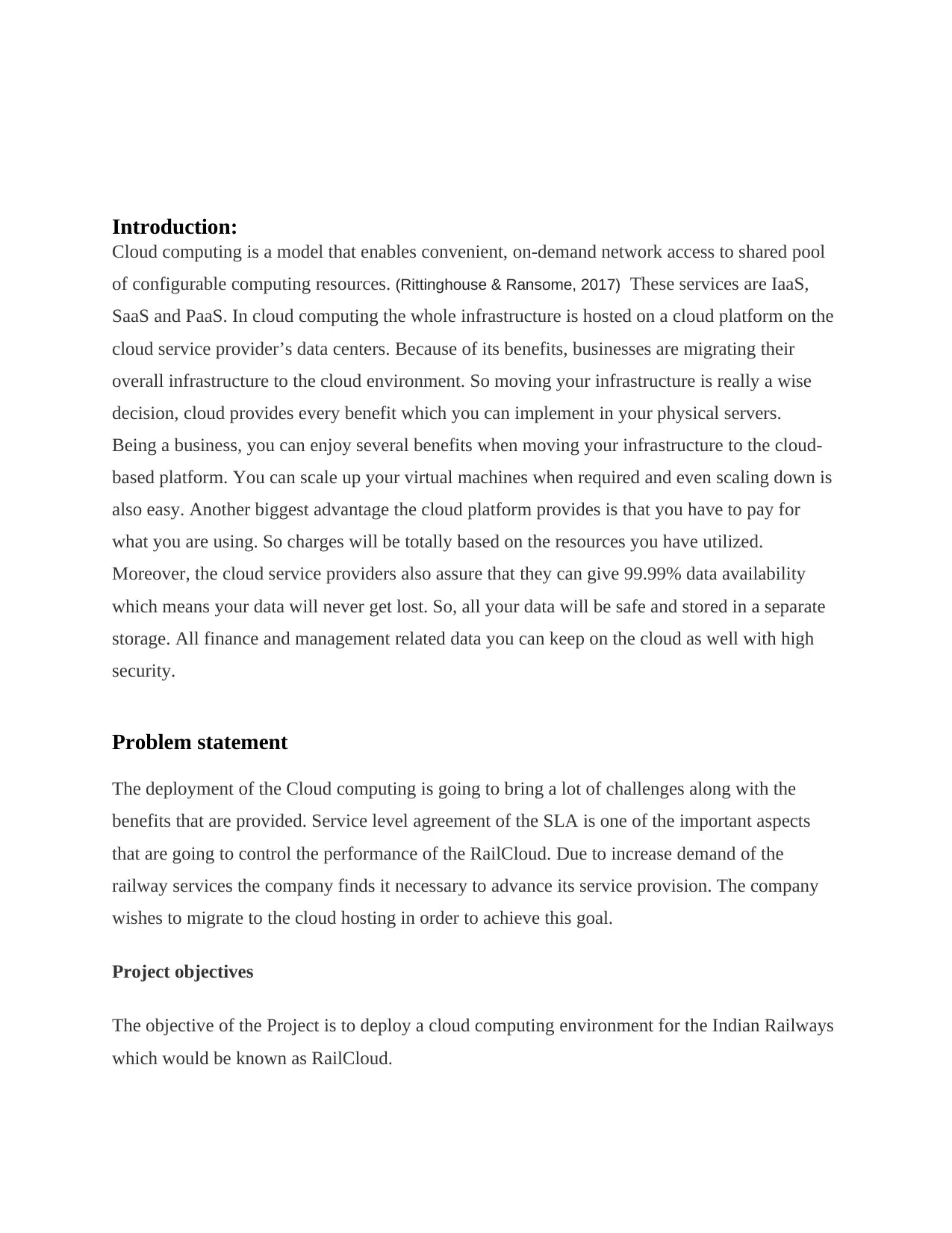
Introduction:
Cloud computing is a model that enables convenient, on-demand network access to shared pool
of configurable computing resources. (Rittinghouse & Ransome, 2017) These services are IaaS,
SaaS and PaaS. In cloud computing the whole infrastructure is hosted on a cloud platform on the
cloud service provider’s data centers. Because of its benefits, businesses are migrating their
overall infrastructure to the cloud environment. So moving your infrastructure is really a wise
decision, cloud provides every benefit which you can implement in your physical servers.
Being a business, you can enjoy several benefits when moving your infrastructure to the cloud-
based platform. You can scale up your virtual machines when required and even scaling down is
also easy. Another biggest advantage the cloud platform provides is that you have to pay for
what you are using. So charges will be totally based on the resources you have utilized.
Moreover, the cloud service providers also assure that they can give 99.99% data availability
which means your data will never get lost. So, all your data will be safe and stored in a separate
storage. All finance and management related data you can keep on the cloud as well with high
security.
Problem statement
The deployment of the Cloud computing is going to bring a lot of challenges along with the
benefits that are provided. Service level agreement of the SLA is one of the important aspects
that are going to control the performance of the RailCloud. Due to increase demand of the
railway services the company finds it necessary to advance its service provision. The company
wishes to migrate to the cloud hosting in order to achieve this goal.
Project objectives
The objective of the Project is to deploy a cloud computing environment for the Indian Railways
which would be known as RailCloud.
Cloud computing is a model that enables convenient, on-demand network access to shared pool
of configurable computing resources. (Rittinghouse & Ransome, 2017) These services are IaaS,
SaaS and PaaS. In cloud computing the whole infrastructure is hosted on a cloud platform on the
cloud service provider’s data centers. Because of its benefits, businesses are migrating their
overall infrastructure to the cloud environment. So moving your infrastructure is really a wise
decision, cloud provides every benefit which you can implement in your physical servers.
Being a business, you can enjoy several benefits when moving your infrastructure to the cloud-
based platform. You can scale up your virtual machines when required and even scaling down is
also easy. Another biggest advantage the cloud platform provides is that you have to pay for
what you are using. So charges will be totally based on the resources you have utilized.
Moreover, the cloud service providers also assure that they can give 99.99% data availability
which means your data will never get lost. So, all your data will be safe and stored in a separate
storage. All finance and management related data you can keep on the cloud as well with high
security.
Problem statement
The deployment of the Cloud computing is going to bring a lot of challenges along with the
benefits that are provided. Service level agreement of the SLA is one of the important aspects
that are going to control the performance of the RailCloud. Due to increase demand of the
railway services the company finds it necessary to advance its service provision. The company
wishes to migrate to the cloud hosting in order to achieve this goal.
Project objectives
The objective of the Project is to deploy a cloud computing environment for the Indian Railways
which would be known as RailCloud.
⊘ This is a preview!⊘
Do you want full access?
Subscribe today to unlock all pages.

Trusted by 1+ million students worldwide
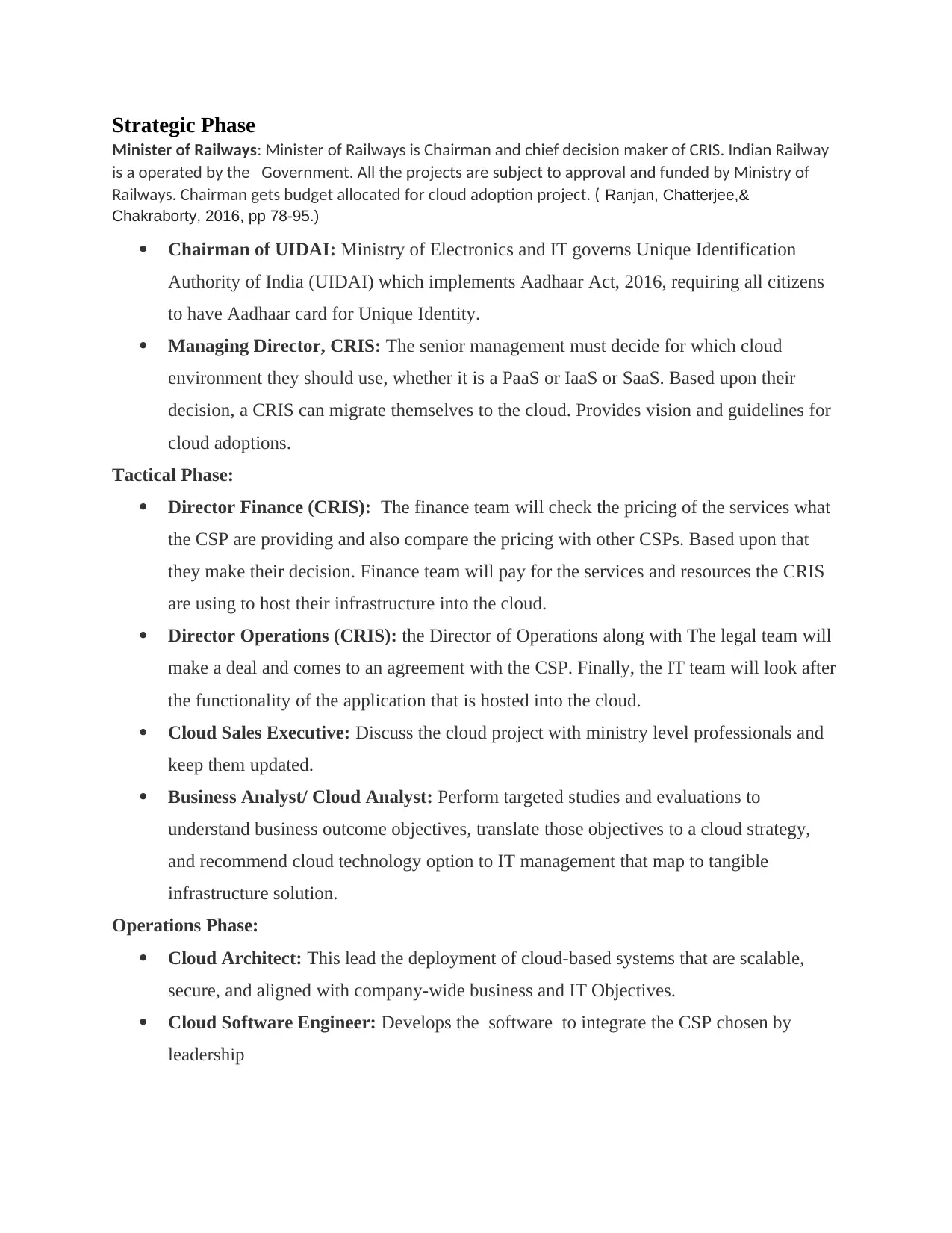
Strategic Phase
Minister of Railways: Minister of Railways is Chairman and chief decision maker of CRIS. Indian Railway
is a operated by the Government. All the projects are subject to approval and funded by Ministry of
Railways. Chairman gets budget allocated for cloud adoption project. ( Ranjan, Chatterjee,&
Chakraborty, 2016, pp 78-95.)
Chairman of UIDAI: Ministry of Electronics and IT governs Unique Identification
Authority of India (UIDAI) which implements Aadhaar Act, 2016, requiring all citizens
to have Aadhaar card for Unique Identity.
Managing Director, CRIS: The senior management must decide for which cloud
environment they should use, whether it is a PaaS or IaaS or SaaS. Based upon their
decision, a CRIS can migrate themselves to the cloud. Provides vision and guidelines for
cloud adoptions.
Tactical Phase:
Director Finance (CRIS): The finance team will check the pricing of the services what
the CSP are providing and also compare the pricing with other CSPs. Based upon that
they make their decision. Finance team will pay for the services and resources the CRIS
are using to host their infrastructure into the cloud.
Director Operations (CRIS): the Director of Operations along with The legal team will
make a deal and comes to an agreement with the CSP. Finally, the IT team will look after
the functionality of the application that is hosted into the cloud.
Cloud Sales Executive: Discuss the cloud project with ministry level professionals and
keep them updated.
Business Analyst/ Cloud Analyst: Perform targeted studies and evaluations to
understand business outcome objectives, translate those objectives to a cloud strategy,
and recommend cloud technology option to IT management that map to tangible
infrastructure solution.
Operations Phase:
Cloud Architect: This lead the deployment of cloud-based systems that are scalable,
secure, and aligned with company-wide business and IT Objectives.
Cloud Software Engineer: Develops the software to integrate the CSP chosen by
leadership
Minister of Railways: Minister of Railways is Chairman and chief decision maker of CRIS. Indian Railway
is a operated by the Government. All the projects are subject to approval and funded by Ministry of
Railways. Chairman gets budget allocated for cloud adoption project. ( Ranjan, Chatterjee,&
Chakraborty, 2016, pp 78-95.)
Chairman of UIDAI: Ministry of Electronics and IT governs Unique Identification
Authority of India (UIDAI) which implements Aadhaar Act, 2016, requiring all citizens
to have Aadhaar card for Unique Identity.
Managing Director, CRIS: The senior management must decide for which cloud
environment they should use, whether it is a PaaS or IaaS or SaaS. Based upon their
decision, a CRIS can migrate themselves to the cloud. Provides vision and guidelines for
cloud adoptions.
Tactical Phase:
Director Finance (CRIS): The finance team will check the pricing of the services what
the CSP are providing and also compare the pricing with other CSPs. Based upon that
they make their decision. Finance team will pay for the services and resources the CRIS
are using to host their infrastructure into the cloud.
Director Operations (CRIS): the Director of Operations along with The legal team will
make a deal and comes to an agreement with the CSP. Finally, the IT team will look after
the functionality of the application that is hosted into the cloud.
Cloud Sales Executive: Discuss the cloud project with ministry level professionals and
keep them updated.
Business Analyst/ Cloud Analyst: Perform targeted studies and evaluations to
understand business outcome objectives, translate those objectives to a cloud strategy,
and recommend cloud technology option to IT management that map to tangible
infrastructure solution.
Operations Phase:
Cloud Architect: This lead the deployment of cloud-based systems that are scalable,
secure, and aligned with company-wide business and IT Objectives.
Cloud Software Engineer: Develops the software to integrate the CSP chosen by
leadership
Paraphrase This Document
Need a fresh take? Get an instant paraphrase of this document with our AI Paraphraser
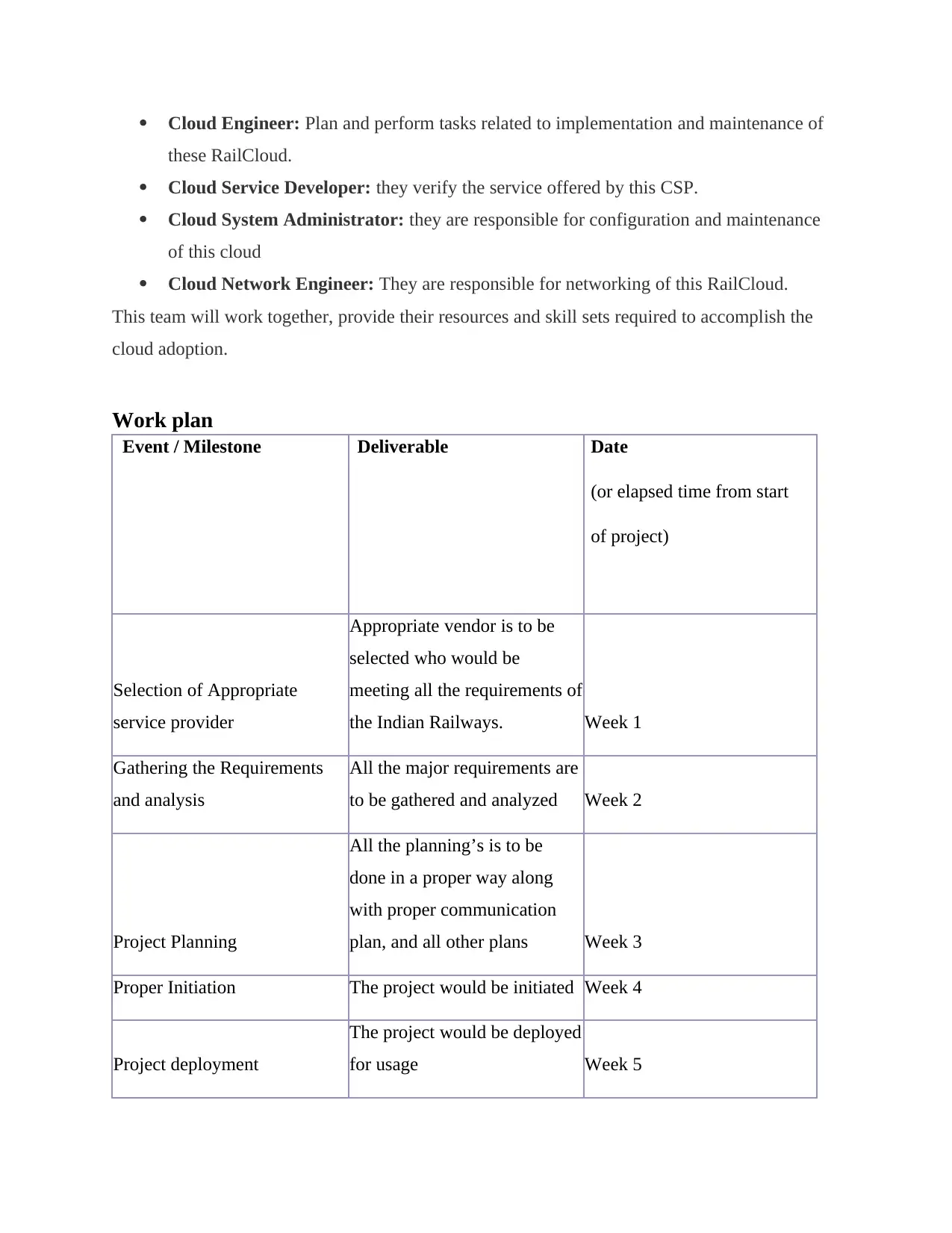
Cloud Engineer: Plan and perform tasks related to implementation and maintenance of
these RailCloud.
Cloud Service Developer: they verify the service offered by this CSP.
Cloud System Administrator: they are responsible for configuration and maintenance
of this cloud
Cloud Network Engineer: They are responsible for networking of this RailCloud.
This team will work together, provide their resources and skill sets required to accomplish the
cloud adoption.
Work plan
Event / Milestone Deliverable Date
(or elapsed time from start
of project)
Selection of Appropriate
service provider
Appropriate vendor is to be
selected who would be
meeting all the requirements of
the Indian Railways. Week 1
Gathering the Requirements
and analysis
All the major requirements are
to be gathered and analyzed Week 2
Project Planning
All the planning’s is to be
done in a proper way along
with proper communication
plan, and all other plans Week 3
Proper Initiation The project would be initiated Week 4
Project deployment
The project would be deployed
for usage Week 5
these RailCloud.
Cloud Service Developer: they verify the service offered by this CSP.
Cloud System Administrator: they are responsible for configuration and maintenance
of this cloud
Cloud Network Engineer: They are responsible for networking of this RailCloud.
This team will work together, provide their resources and skill sets required to accomplish the
cloud adoption.
Work plan
Event / Milestone Deliverable Date
(or elapsed time from start
of project)
Selection of Appropriate
service provider
Appropriate vendor is to be
selected who would be
meeting all the requirements of
the Indian Railways. Week 1
Gathering the Requirements
and analysis
All the major requirements are
to be gathered and analyzed Week 2
Project Planning
All the planning’s is to be
done in a proper way along
with proper communication
plan, and all other plans Week 3
Proper Initiation The project would be initiated Week 4
Project deployment
The project would be deployed
for usage Week 5
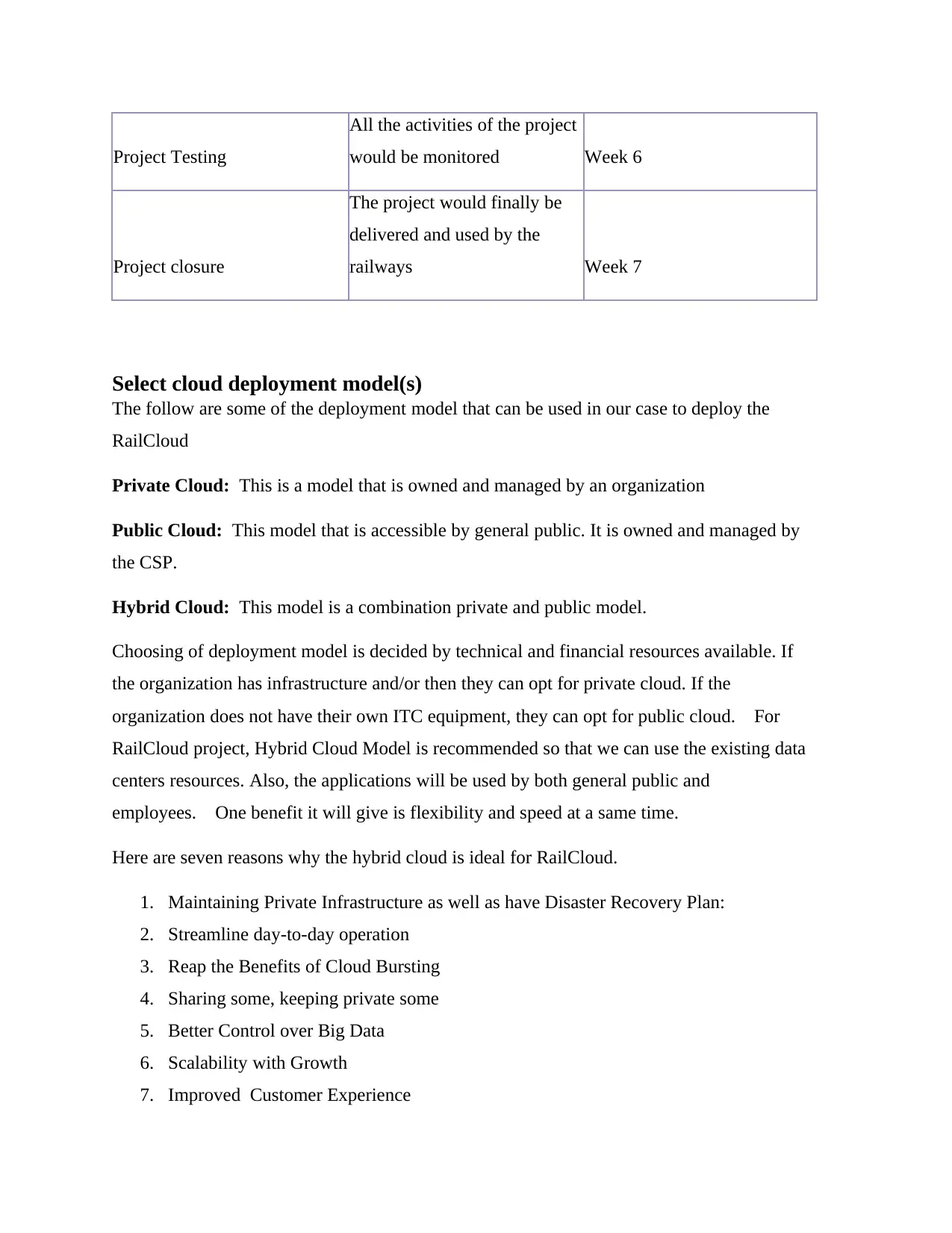
Project Testing
All the activities of the project
would be monitored Week 6
Project closure
The project would finally be
delivered and used by the
railways Week 7
Select cloud deployment model(s)
The follow are some of the deployment model that can be used in our case to deploy the
RailCloud
Private Cloud: This is a model that is owned and managed by an organization
Public Cloud: This model that is accessible by general public. It is owned and managed by
the CSP.
Hybrid Cloud: This model is a combination private and public model.
Choosing of deployment model is decided by technical and financial resources available. If
the organization has infrastructure and/or then they can opt for private cloud. If the
organization does not have their own ITC equipment, they can opt for public cloud. For
RailCloud project, Hybrid Cloud Model is recommended so that we can use the existing data
centers resources. Also, the applications will be used by both general public and
employees. One benefit it will give is flexibility and speed at a same time.
Here are seven reasons why the hybrid cloud is ideal for RailCloud.
1. Maintaining Private Infrastructure as well as have Disaster Recovery Plan:
2. Streamline day-to-day operation
3. Reap the Benefits of Cloud Bursting
4. Sharing some, keeping private some
5. Better Control over Big Data
6. Scalability with Growth
7. Improved Customer Experience
All the activities of the project
would be monitored Week 6
Project closure
The project would finally be
delivered and used by the
railways Week 7
Select cloud deployment model(s)
The follow are some of the deployment model that can be used in our case to deploy the
RailCloud
Private Cloud: This is a model that is owned and managed by an organization
Public Cloud: This model that is accessible by general public. It is owned and managed by
the CSP.
Hybrid Cloud: This model is a combination private and public model.
Choosing of deployment model is decided by technical and financial resources available. If
the organization has infrastructure and/or then they can opt for private cloud. If the
organization does not have their own ITC equipment, they can opt for public cloud. For
RailCloud project, Hybrid Cloud Model is recommended so that we can use the existing data
centers resources. Also, the applications will be used by both general public and
employees. One benefit it will give is flexibility and speed at a same time.
Here are seven reasons why the hybrid cloud is ideal for RailCloud.
1. Maintaining Private Infrastructure as well as have Disaster Recovery Plan:
2. Streamline day-to-day operation
3. Reap the Benefits of Cloud Bursting
4. Sharing some, keeping private some
5. Better Control over Big Data
6. Scalability with Growth
7. Improved Customer Experience
⊘ This is a preview!⊘
Do you want full access?
Subscribe today to unlock all pages.

Trusted by 1+ million students worldwide
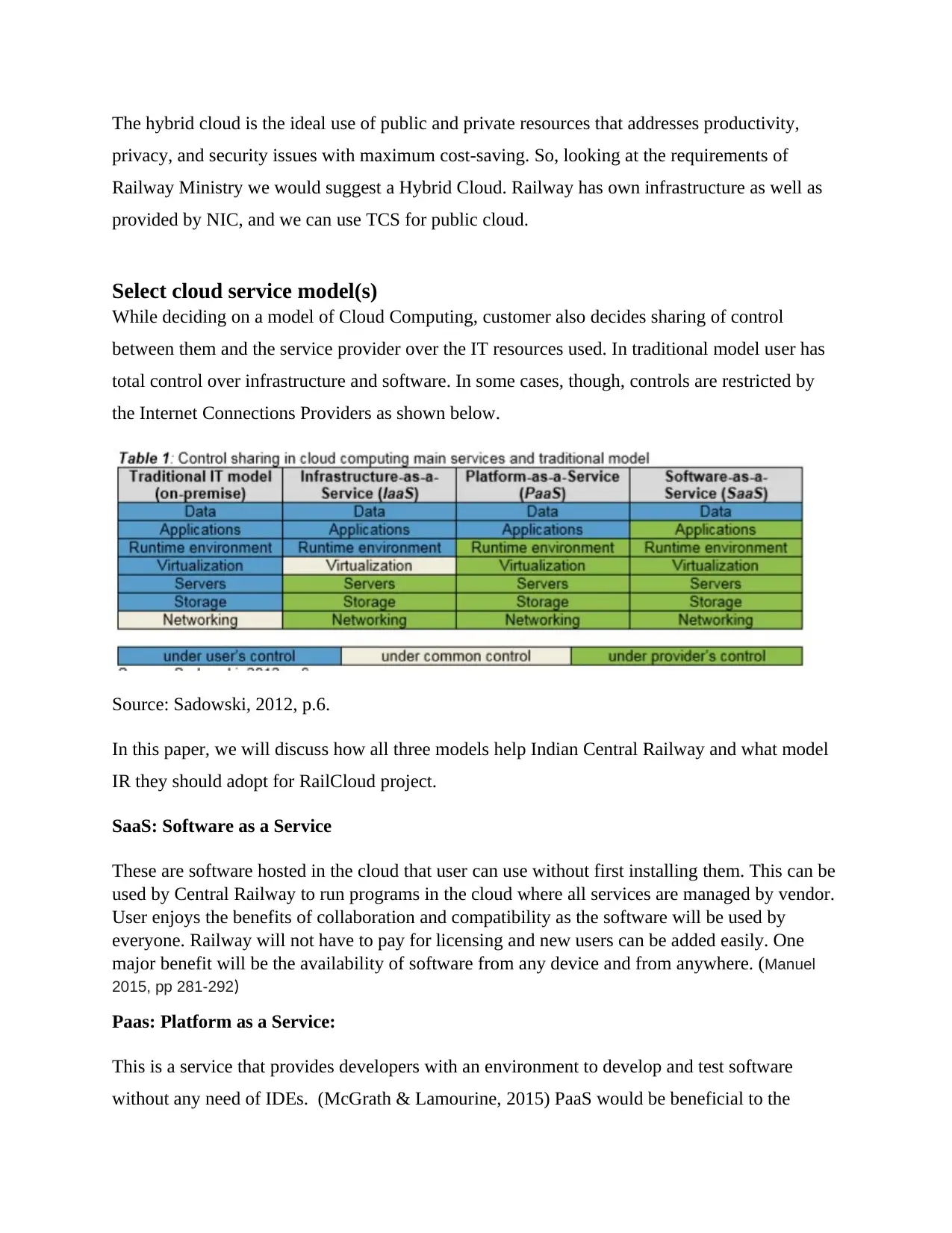
The hybrid cloud is the ideal use of public and private resources that addresses productivity,
privacy, and security issues with maximum cost-saving. So, looking at the requirements of
Railway Ministry we would suggest a Hybrid Cloud. Railway has own infrastructure as well as
provided by NIC, and we can use TCS for public cloud.
Select cloud service model(s)
While deciding on a model of Cloud Computing, customer also decides sharing of control
between them and the service provider over the IT resources used. In traditional model user has
total control over infrastructure and software. In some cases, though, controls are restricted by
the Internet Connections Providers as shown below.
Source: Sadowski, 2012, p.6.
In this paper, we will discuss how all three models help Indian Central Railway and what model
IR they should adopt for RailCloud project.
SaaS: Software as a Service
These are software hosted in the cloud that user can use without first installing them. This can be
used by Central Railway to run programs in the cloud where all services are managed by vendor.
User enjoys the benefits of collaboration and compatibility as the software will be used by
everyone. Railway will not have to pay for licensing and new users can be added easily. One
major benefit will be the availability of software from any device and from anywhere. (Manuel
2015, pp 281-292)
Paas: Platform as a Service:
This is a service that provides developers with an environment to develop and test software
without any need of IDEs. (McGrath & Lamourine, 2015) PaaS would be beneficial to the
privacy, and security issues with maximum cost-saving. So, looking at the requirements of
Railway Ministry we would suggest a Hybrid Cloud. Railway has own infrastructure as well as
provided by NIC, and we can use TCS for public cloud.
Select cloud service model(s)
While deciding on a model of Cloud Computing, customer also decides sharing of control
between them and the service provider over the IT resources used. In traditional model user has
total control over infrastructure and software. In some cases, though, controls are restricted by
the Internet Connections Providers as shown below.
Source: Sadowski, 2012, p.6.
In this paper, we will discuss how all three models help Indian Central Railway and what model
IR they should adopt for RailCloud project.
SaaS: Software as a Service
These are software hosted in the cloud that user can use without first installing them. This can be
used by Central Railway to run programs in the cloud where all services are managed by vendor.
User enjoys the benefits of collaboration and compatibility as the software will be used by
everyone. Railway will not have to pay for licensing and new users can be added easily. One
major benefit will be the availability of software from any device and from anywhere. (Manuel
2015, pp 281-292)
Paas: Platform as a Service:
This is a service that provides developers with an environment to develop and test software
without any need of IDEs. (McGrath & Lamourine, 2015) PaaS would be beneficial to the
Paraphrase This Document
Need a fresh take? Get an instant paraphrase of this document with our AI Paraphraser

services of Central Railways in application testing or development as it will eliminate cost for up
keeping the hardware.
keeping the hardware.
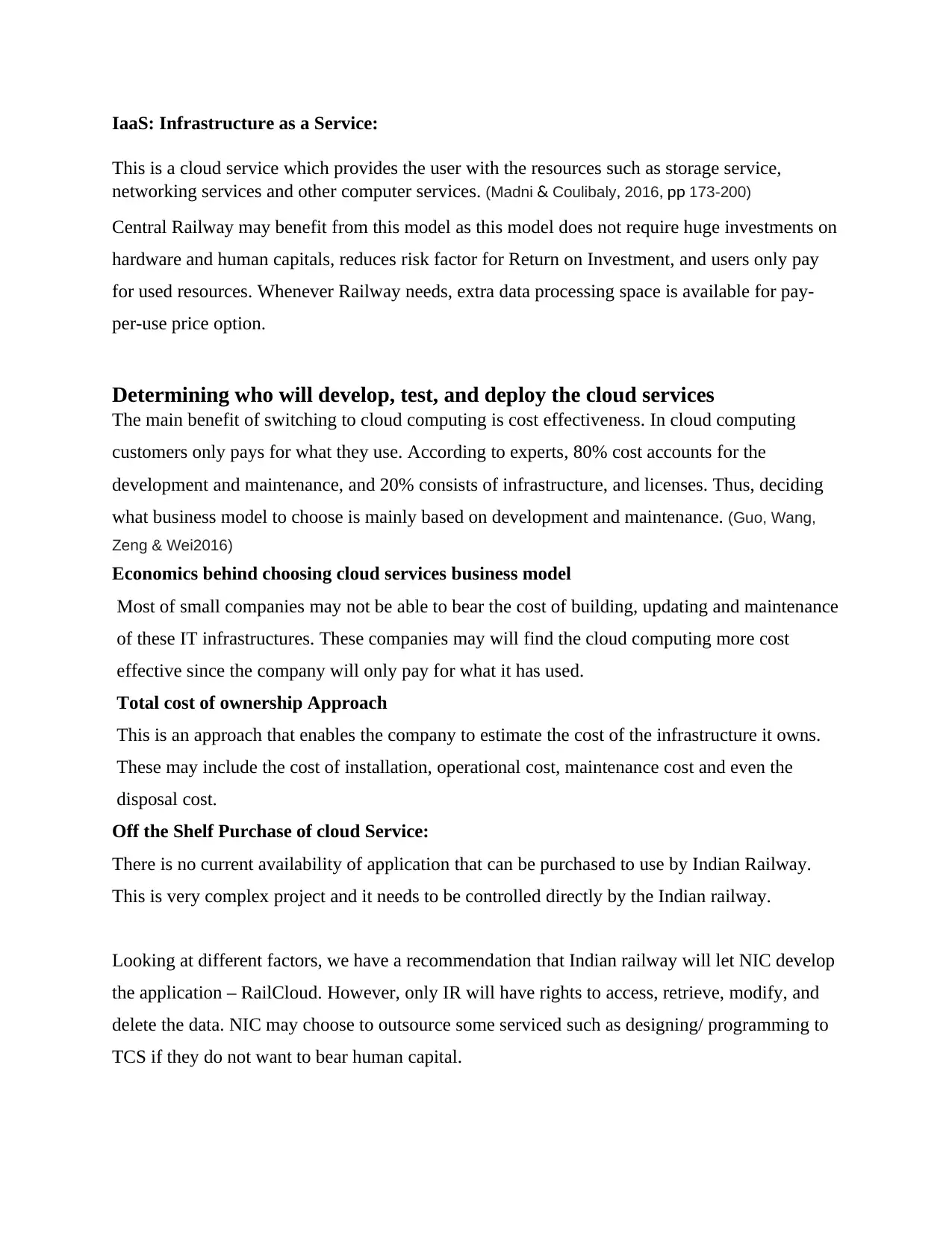
IaaS: Infrastructure as a Service:
This is a cloud service which provides the user with the resources such as storage service,
networking services and other computer services. (Madni & Coulibaly, 2016, pp 173-200)
Central Railway may benefit from this model as this model does not require huge investments on
hardware and human capitals, reduces risk factor for Return on Investment, and users only pay
for used resources. Whenever Railway needs, extra data processing space is available for pay-
per-use price option.
Determining who will develop, test, and deploy the cloud services
The main benefit of switching to cloud computing is cost effectiveness. In cloud computing
customers only pays for what they use. According to experts, 80% cost accounts for the
development and maintenance, and 20% consists of infrastructure, and licenses. Thus, deciding
what business model to choose is mainly based on development and maintenance. (Guo, Wang,
Zeng & Wei2016)
Economics behind choosing cloud services business model
Most of small companies may not be able to bear the cost of building, updating and maintenance
of these IT infrastructures. These companies may will find the cloud computing more cost
effective since the company will only pay for what it has used.
Total cost of ownership Approach
This is an approach that enables the company to estimate the cost of the infrastructure it owns.
These may include the cost of installation, operational cost, maintenance cost and even the
disposal cost.
Off the Shelf Purchase of cloud Service:
There is no current availability of application that can be purchased to use by Indian Railway.
This is very complex project and it needs to be controlled directly by the Indian railway.
Looking at different factors, we have a recommendation that Indian railway will let NIC develop
the application – RailCloud. However, only IR will have rights to access, retrieve, modify, and
delete the data. NIC may choose to outsource some serviced such as designing/ programming to
TCS if they do not want to bear human capital.
This is a cloud service which provides the user with the resources such as storage service,
networking services and other computer services. (Madni & Coulibaly, 2016, pp 173-200)
Central Railway may benefit from this model as this model does not require huge investments on
hardware and human capitals, reduces risk factor for Return on Investment, and users only pay
for used resources. Whenever Railway needs, extra data processing space is available for pay-
per-use price option.
Determining who will develop, test, and deploy the cloud services
The main benefit of switching to cloud computing is cost effectiveness. In cloud computing
customers only pays for what they use. According to experts, 80% cost accounts for the
development and maintenance, and 20% consists of infrastructure, and licenses. Thus, deciding
what business model to choose is mainly based on development and maintenance. (Guo, Wang,
Zeng & Wei2016)
Economics behind choosing cloud services business model
Most of small companies may not be able to bear the cost of building, updating and maintenance
of these IT infrastructures. These companies may will find the cloud computing more cost
effective since the company will only pay for what it has used.
Total cost of ownership Approach
This is an approach that enables the company to estimate the cost of the infrastructure it owns.
These may include the cost of installation, operational cost, maintenance cost and even the
disposal cost.
Off the Shelf Purchase of cloud Service:
There is no current availability of application that can be purchased to use by Indian Railway.
This is very complex project and it needs to be controlled directly by the Indian railway.
Looking at different factors, we have a recommendation that Indian railway will let NIC develop
the application – RailCloud. However, only IR will have rights to access, retrieve, modify, and
delete the data. NIC may choose to outsource some serviced such as designing/ programming to
TCS if they do not want to bear human capital.
⊘ This is a preview!⊘
Do you want full access?
Subscribe today to unlock all pages.

Trusted by 1+ million students worldwide
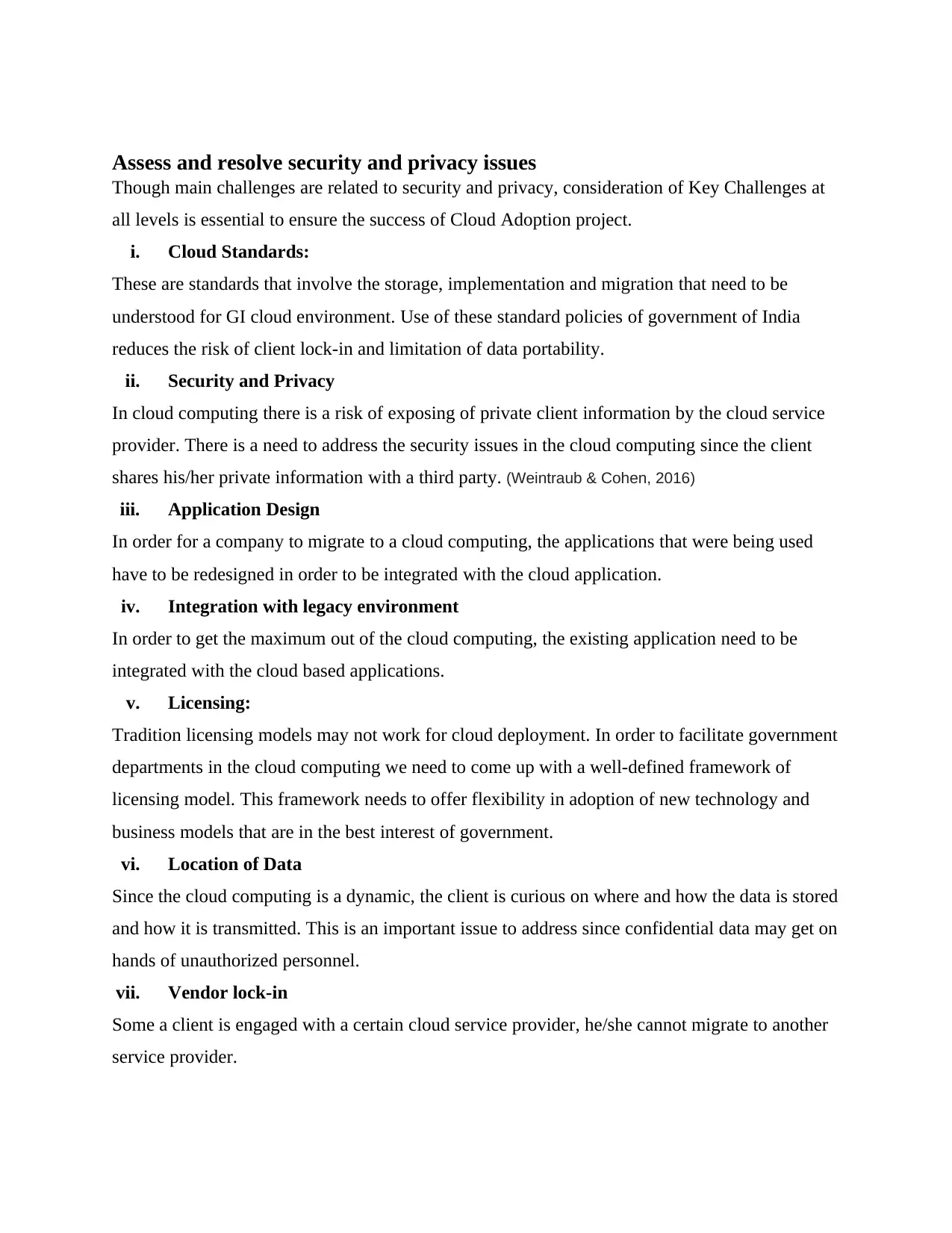
Assess and resolve security and privacy issues
Though main challenges are related to security and privacy, consideration of Key Challenges at
all levels is essential to ensure the success of Cloud Adoption project.
i. Cloud Standards:
These are standards that involve the storage, implementation and migration that need to be
understood for GI cloud environment. Use of these standard policies of government of India
reduces the risk of client lock-in and limitation of data portability.
ii. Security and Privacy
In cloud computing there is a risk of exposing of private client information by the cloud service
provider. There is a need to address the security issues in the cloud computing since the client
shares his/her private information with a third party. (Weintraub & Cohen, 2016)
iii. Application Design
In order for a company to migrate to a cloud computing, the applications that were being used
have to be redesigned in order to be integrated with the cloud application.
iv. Integration with legacy environment
In order to get the maximum out of the cloud computing, the existing application need to be
integrated with the cloud based applications.
v. Licensing:
Tradition licensing models may not work for cloud deployment. In order to facilitate government
departments in the cloud computing we need to come up with a well-defined framework of
licensing model. This framework needs to offer flexibility in adoption of new technology and
business models that are in the best interest of government.
vi. Location of Data
Since the cloud computing is a dynamic, the client is curious on where and how the data is stored
and how it is transmitted. This is an important issue to address since confidential data may get on
hands of unauthorized personnel.
vii. Vendor lock-in
Some a client is engaged with a certain cloud service provider, he/she cannot migrate to another
service provider.
Though main challenges are related to security and privacy, consideration of Key Challenges at
all levels is essential to ensure the success of Cloud Adoption project.
i. Cloud Standards:
These are standards that involve the storage, implementation and migration that need to be
understood for GI cloud environment. Use of these standard policies of government of India
reduces the risk of client lock-in and limitation of data portability.
ii. Security and Privacy
In cloud computing there is a risk of exposing of private client information by the cloud service
provider. There is a need to address the security issues in the cloud computing since the client
shares his/her private information with a third party. (Weintraub & Cohen, 2016)
iii. Application Design
In order for a company to migrate to a cloud computing, the applications that were being used
have to be redesigned in order to be integrated with the cloud application.
iv. Integration with legacy environment
In order to get the maximum out of the cloud computing, the existing application need to be
integrated with the cloud based applications.
v. Licensing:
Tradition licensing models may not work for cloud deployment. In order to facilitate government
departments in the cloud computing we need to come up with a well-defined framework of
licensing model. This framework needs to offer flexibility in adoption of new technology and
business models that are in the best interest of government.
vi. Location of Data
Since the cloud computing is a dynamic, the client is curious on where and how the data is stored
and how it is transmitted. This is an important issue to address since confidential data may get on
hands of unauthorized personnel.
vii. Vendor lock-in
Some a client is engaged with a certain cloud service provider, he/she cannot migrate to another
service provider.
Paraphrase This Document
Need a fresh take? Get an instant paraphrase of this document with our AI Paraphraser
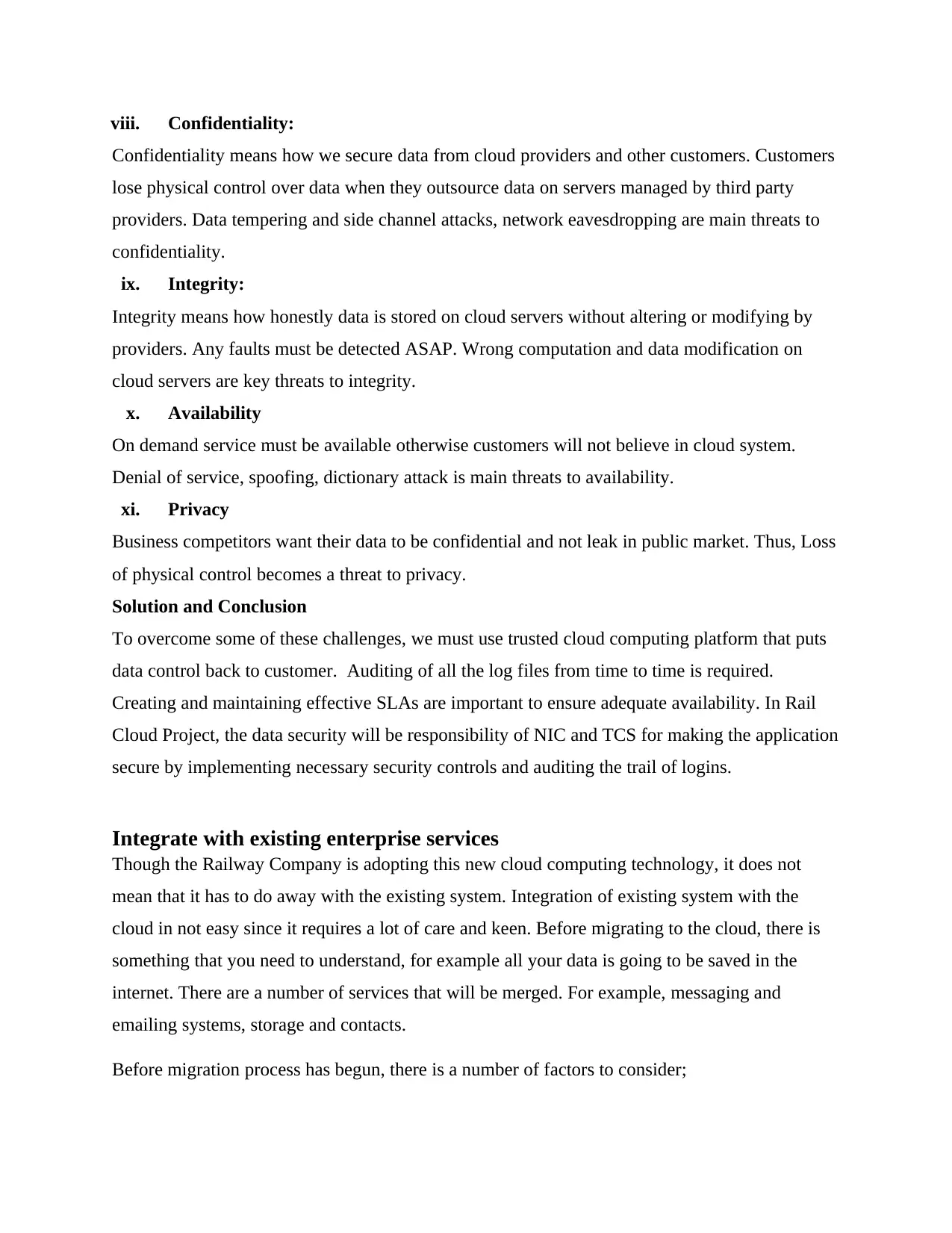
viii. Confidentiality:
Confidentiality means how we secure data from cloud providers and other customers. Customers
lose physical control over data when they outsource data on servers managed by third party
providers. Data tempering and side channel attacks, network eavesdropping are main threats to
confidentiality.
ix. Integrity:
Integrity means how honestly data is stored on cloud servers without altering or modifying by
providers. Any faults must be detected ASAP. Wrong computation and data modification on
cloud servers are key threats to integrity.
x. Availability
On demand service must be available otherwise customers will not believe in cloud system.
Denial of service, spoofing, dictionary attack is main threats to availability.
xi. Privacy
Business competitors want their data to be confidential and not leak in public market. Thus, Loss
of physical control becomes a threat to privacy.
Solution and Conclusion
To overcome some of these challenges, we must use trusted cloud computing platform that puts
data control back to customer. Auditing of all the log files from time to time is required.
Creating and maintaining effective SLAs are important to ensure adequate availability. In Rail
Cloud Project, the data security will be responsibility of NIC and TCS for making the application
secure by implementing necessary security controls and auditing the trail of logins.
Integrate with existing enterprise services
Though the Railway Company is adopting this new cloud computing technology, it does not
mean that it has to do away with the existing system. Integration of existing system with the
cloud in not easy since it requires a lot of care and keen. Before migrating to the cloud, there is
something that you need to understand, for example all your data is going to be saved in the
internet. There are a number of services that will be merged. For example, messaging and
emailing systems, storage and contacts.
Before migration process has begun, there is a number of factors to consider;
Confidentiality means how we secure data from cloud providers and other customers. Customers
lose physical control over data when they outsource data on servers managed by third party
providers. Data tempering and side channel attacks, network eavesdropping are main threats to
confidentiality.
ix. Integrity:
Integrity means how honestly data is stored on cloud servers without altering or modifying by
providers. Any faults must be detected ASAP. Wrong computation and data modification on
cloud servers are key threats to integrity.
x. Availability
On demand service must be available otherwise customers will not believe in cloud system.
Denial of service, spoofing, dictionary attack is main threats to availability.
xi. Privacy
Business competitors want their data to be confidential and not leak in public market. Thus, Loss
of physical control becomes a threat to privacy.
Solution and Conclusion
To overcome some of these challenges, we must use trusted cloud computing platform that puts
data control back to customer. Auditing of all the log files from time to time is required.
Creating and maintaining effective SLAs are important to ensure adequate availability. In Rail
Cloud Project, the data security will be responsibility of NIC and TCS for making the application
secure by implementing necessary security controls and auditing the trail of logins.
Integrate with existing enterprise services
Though the Railway Company is adopting this new cloud computing technology, it does not
mean that it has to do away with the existing system. Integration of existing system with the
cloud in not easy since it requires a lot of care and keen. Before migrating to the cloud, there is
something that you need to understand, for example all your data is going to be saved in the
internet. There are a number of services that will be merged. For example, messaging and
emailing systems, storage and contacts.
Before migration process has begun, there is a number of factors to consider;

⊘ This is a preview!⊘
Do you want full access?
Subscribe today to unlock all pages.

Trusted by 1+ million students worldwide
1 out of 16
Related Documents
Your All-in-One AI-Powered Toolkit for Academic Success.
+13062052269
info@desklib.com
Available 24*7 on WhatsApp / Email
![[object Object]](/_next/static/media/star-bottom.7253800d.svg)
Unlock your academic potential
Copyright © 2020–2025 A2Z Services. All Rights Reserved. Developed and managed by ZUCOL.



